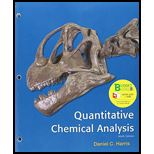
Interpretation:
The equivalence volume of
Concept introduction:
Volumetric principle:
The volume and concentration of unknown solution is determined by it is titrate with known volume and concentration solution.
The volume and concentration of unknown solution is required equivalent volume and concentration of known solution in the volumetric titration.
Where,
Degree of dissociation:
The ratio of mole of reactant that underwent to dissociating to mole of initial reactant is known as degree of dissociation.
In EDTA the degree of dissociation is,
If pH is fixed, the degree of dissociation
Where,
Answer to Problem 12.7P
The volume of solution at equivalent point is
The conditional formation value is
Explanation of Solution
To determine the volume of solution at equivalent point in
Given,
Volume of known solution is
Concentration of known solution is
Concentration of
According to the volumetric principle,
The given values are plugged in above equation to give a volume of solution at equivalent point in
To give the degree of dissociation
Given,
From the standard data table the
The conditional formation value is
The equivalence volume of
(a)
Interpretation:
The
Conditional Formation Constant:
In the reaction of metal with ligand, the equilibrium constant is called as formation constant or the stability constant.
The formation constant for above complex reaction is,
Where,
If pH is constant, the degree of dissociation
Where,
(a)
Answer to Problem 12.7P
The
Explanation of Solution
To determine the
Given,
Equivalent point in
Volume of different is
The volume difference and concentration are plugged in above equation to give
The
(b)
Interpretation:
At the equivalent point, the
Concept Information:
Degree of dissociation:
The ratio of mole of reactant that underwent to dissociating to mole of initial reactant is known as degree of dissociation.
In EDTA the degree of dissociation is,
If pH is fixed, the degree of dissociation
Where,
(b)
Explanation of Solution
To calculate the
The equilibrium reaction is,
The concentration of
From the above calculation the
Hence, the
The
The
At the equivalent point, the
(c)
Interpretation:
At
Concept Information:
Conditional Formation Constant:
In the reaction of metal with ligand, the equilibrium constant is called as formation constant or the stability constant.
The formation constant for above complex reaction is,
Where,
If pH is constant, the degree of dissociation
Where,
(c)
Answer to Problem 12.7P
At
Explanation of Solution
To calculate the
Given,
To calculate the
The equilibrium reaction is,
The concentration of
Formal concentration of EDTA is,
The
The calculated EDTA concentration and
At
Want to see more full solutions like this?
Chapter 12 Solutions
Quantitative Chemical Analysis:
 ChemistryChemistryISBN:9781305957404Author:Steven S. Zumdahl, Susan A. Zumdahl, Donald J. DeCostePublisher:Cengage Learning
ChemistryChemistryISBN:9781305957404Author:Steven S. Zumdahl, Susan A. Zumdahl, Donald J. DeCostePublisher:Cengage Learning ChemistryChemistryISBN:9781259911156Author:Raymond Chang Dr., Jason Overby ProfessorPublisher:McGraw-Hill Education
ChemistryChemistryISBN:9781259911156Author:Raymond Chang Dr., Jason Overby ProfessorPublisher:McGraw-Hill Education Principles of Instrumental AnalysisChemistryISBN:9781305577213Author:Douglas A. Skoog, F. James Holler, Stanley R. CrouchPublisher:Cengage Learning
Principles of Instrumental AnalysisChemistryISBN:9781305577213Author:Douglas A. Skoog, F. James Holler, Stanley R. CrouchPublisher:Cengage Learning Organic ChemistryChemistryISBN:9780078021558Author:Janice Gorzynski Smith Dr.Publisher:McGraw-Hill Education
Organic ChemistryChemistryISBN:9780078021558Author:Janice Gorzynski Smith Dr.Publisher:McGraw-Hill Education Chemistry: Principles and ReactionsChemistryISBN:9781305079373Author:William L. Masterton, Cecile N. HurleyPublisher:Cengage Learning
Chemistry: Principles and ReactionsChemistryISBN:9781305079373Author:William L. Masterton, Cecile N. HurleyPublisher:Cengage Learning Elementary Principles of Chemical Processes, Bind...ChemistryISBN:9781118431221Author:Richard M. Felder, Ronald W. Rousseau, Lisa G. BullardPublisher:WILEY
Elementary Principles of Chemical Processes, Bind...ChemistryISBN:9781118431221Author:Richard M. Felder, Ronald W. Rousseau, Lisa G. BullardPublisher:WILEY





